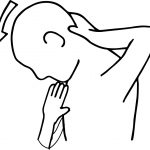The diagnosis of cervical headache is frequently under-diagnosed. Many symptoms are similar to other classifications of headache such as tension headache, migraine, hormonal headache and even cluster headache. There may be clear dietary, environmental or hormonal triggers for the onset of the patient’s headache. However, it is common that these triggers are only active when there is an increased sensitivity in the structures of the upper cervical spine.
Cervical headaches are usually described as a constant, steady, dull ache. It can be to one side or both sides. It can also feel like a pulling or gripping feeling, sometimes a tight band around the head. The headache usually is felt at the base of the skull and can be referred to the front of the head to the temple area or over and behind the eyes. The headaches usually come on over a period of time, gradually getting worse. The headaches may be present for days, weeks even months. Sometimes there may be a history of an acute trauma such as whip-lash injury or repetitive trauma associated with work or a sporting activity.
The Physio will thoroughly assess your neck and headaches. They will ask specific questions to rule out other causes of headaches. They will then feel and assess the structures of your neck to decide if they may be causing your headache. If the neck structures are involved, the physio may find:
- Tight and painful structures in your neck (joint and muscle)
- Pressure on specific structures of your neck will reproduce your head pain
- A forward head posture and stiff mid back
- Reduced motion in the upper joints of the neck
- Reduced endurance in the deep muscles of the neck
After correctly diagnosing the neck as the cause of headache, treatment may be quite straightforward. Physios may use:
Postural Assessment and Advice – Education on optimal trunk posture and postural retraining is vital. Without postural correction cervical headaches can linger for extended periods.
Mobilisation – Stiff joints in the neck should be mobilised to restore range of movement. Stiffness in the jaw joints can also be problematic and should be mobilised if needed.
Stretching – Stretching of the neck and shoulder muscles can help alleviate headaches.
Strengthening – cervical muscle retraining is vital. Your physiotherapist will show you how to retrain your deep neck muscles to restore the normal muscle balance.
Stress and tension management – Identification and reduction of the sources of stress and tension need to be incorporated as this commonly leads to tightness in the upper back and neck muscles.
Soft tissue work and massage – Your physiotherapist may use different massage and soft tissue techniques to help the muscles in your neck and upper back.
Dry needling – Dry needling is the placement of very thin needles into specific locations (trigger points) in the body. It is often used to help alleviate headaches.
Workplace and ergonomic assessment – A poor chair, a desk at the wrong height or wrong set-up or badly placed computer may result in poor posture contributing to strain on the neck. Your Physiotherapist can advise on office and workplace set up.
Neural stretching – Abnormal neural tension can also contribute to cervical headaches. Your physiotherapist will assess this and provide appropriate stretches as needed
Stretch of the Month
This gentle stretch can help alleviate the aches associated with tight muscles around the neck and upper back. This can be done first thing in the morning, as well as during breaks at work to help minimise tightness and decrease the potential of tension related headaches.
- Gently bend your head forwards with one hand whilst guiding your chin towards your chest with the other until you start to feel a stretch at the back of the neck.
- Hold this position for 30 seconds and repeat a few times
Towards Wellness
Thought for Today Tomorrow……
Become aware of your thoughts. If you think negatively all the time, you are going to live in fear. This makes it impossible to ever live a happy life. The truth is our thoughts are our reality. This means that if you don’t want something as a reality in your life – stop thinking about it!

